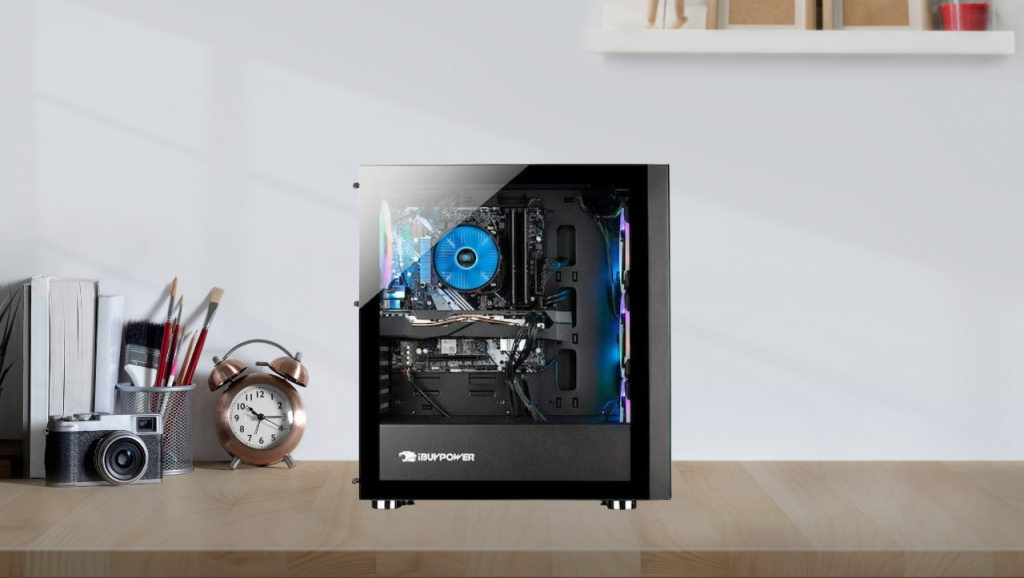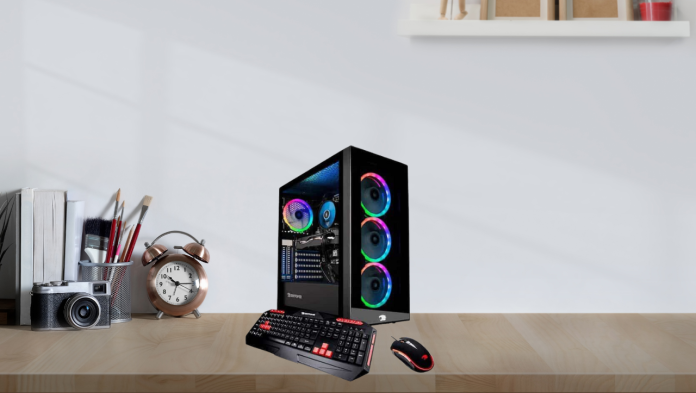Best Deal Today
The iBUYPOWER gaming line is expanding in a big way this year with lots of new gaming desktops. The iBUYPOWER Element 9260 is the middle sibling we’re reviewing following its powerful brother, the iBUYPOWER Elite Trace PRO9300, that features a top of the range Intel Core I9-9900K (8-core) processor, a Turing-based Nvidia GeForce RTX 2080 Super graphics card and 1TB SSD storage. It’s among the best you can get in the company’s gaming line, but costs fairly less than similarly-specced gaming rigs from mainstream manufacturers like HP and Dell.
On the other hand, our review unit is one of those more modest options, a mid-tower that falls somewhere between desktop entry level and midrange in terms of cost and power. With Nvidia GeForce GTX 1660 Ti graphics and a snappy Intel Core i7-9700F, the Element 9260 makes for a capable HD gaming machine, with a few real drawbacks.
Design
Its design and feature set may not be particularly unique in PC gaming, it shares a case with the CYBERPOWERPC Gamer Xtreme GXiVR8060A8 – Our Editors’ Choice for midrange gaming desktops. If you want a different case, though, consider the iBUYPOWER Trace2 9250 that packs the same components as the Element 9260, but instead of three LED rings on the front panel goes for a brushed front with a pair of LED strings and RGB lights running on the sides.
The mid-tower chassis measures 22 by 12.8 by 20.5 inches (HWD) and weighs 31.6 pounds, which is exactly the same dimensions you have on the Trace2 9250, only that the latter is slightly lighter at 29.8 pounds. To access the internal components, all you do is remove four thumbscrews that hold the transparent side glass panel, otherwise it offers tool-less access.
Once you remove the tinted glass panel, you can now access the motherboard, solid-state drive, RAM and graphics card. The power supply and hard drive are found behind a metal side panel on the opposite side. The tinted glass panel looks clean on the system when switched off, and the trio-of LED rings on the front panel looks even better when the machine is running. All that is accented by excellent cable arrangement, that keeps things tidy and helps with airflow.
iBUYPOWER Element 9260 ports
Port selection along the top panel edge (right after the dust filter) includes separate headphone and microphone jacks, and a pair of USB Type-A 3.0 ports. On the same flank, you also have a power button, a reset button, and a drive activity light up. We’d prefer a flash-card reader in this spot, though. That’s about one of the few conveniences missing here. On the bottom, you have four raised feet with rubber pads to give the Gamer Xtreme some breathing room from the underside.
On the back of the tower, there are other ports including four USB ports, Ethernet jack, two legacy PS/2 ports to accommodate your older mouse and keyboard connections, audio and headphone jacks, and video output ports, including DisplayPort and HDMI connections.
Our review unit tops with a GTX 1660 Ti graphics card, but you have units in the same series with the beefier RTX card, meaning you don’t get USB-C here (available in the high-end models), but still a good configuration for the price. While the GTX 1660 delivers enough power to drive a VR headset, and the RTX 2080 includes a USB-C port, meaning it you can benefit from the single VirtualLink connector. With the Gamer Xtreme GXiVR8060A8 you’ll have to do with multiple cables to drive your headset.

Performance
While you’ll be buying the Element 9260 for gaming, that doesn’t mean it can’t do other tasks around the house. In fact, I see small business owners and home users integrating such systems into their daily operations, thanks to the machine’s capable processor and graphics card. We are looking at a 9th-generation Intel Core i7-9700F (3.0GHz), 16GB DDR4 RAM, 240GB SSD and 1TB hard drive running on Windows 10 Home operating system.
Paired with a Full HD monitor like the Sceptre E255B-1658A or the Acer SB220Q bi, that’s a solid feature set that will let you run the most of demanding tasks around. You can browse the web, do some photo editing, run some demanding applications like Photoshop. It’s also possible to do video encoding, although you’ll need more time to complete graphic-intensive tasks, but its performance is well above the upper-range of budget desktop PCs.
Nvidia GTX 1660 Ti & Virtual Reality
Our review unit offers an entry-level Nvidia GeForce GTX 1660 Ti graphics card, something most enthusiast gamers will find likeable, especially those who don’t need features like real-time ray tracing and deep learning super sampling (DLSS) found on high-end Turing graphics cards like the RTX 2080 Super found on the CyberPowerPC Gamer Xtreme GXiVR8080A7 and the 2020 RTX 3080 GPUs.
With the GTX 1660 Ti, Nvidia gives up on technologies like DLSS in order to hit a lower price point, and it looks like a winning strategy for midrange gamers who don’t have a budget for the most expensive graphics card around. However, this TU116 GPU raises the question of just how low Nvidia is willing to go with its Turing architecture.
Unlike the high-end RTX 2080, the GeForce GTX 1660 Ti (6GB) trims down to a readily available GDDR5 instead of the newer GDDR6, along with fewer CUDA cores and less other elements. The result is what you’ve already guessed: a slightly lower but more affordable graphics card for budget gaming/mainstream PCs.
At the end of the day, you’re getting more performance for less money – it even supports VR headsets. And, that’s great. For instance, you get some architectural enhancements, higher clock speeds, more shade cores over last year’s Nvidia GTX 1060 (GPU). The GPU at the heart of the GTX 1660 Ti is the same as TU116 found in the 1660, only that two SMs have been disabled on the latter, in turn disabling 128 CUDA cores and 8 texture units.
Gaming Performance
The new GTX 1660 graphics card does a good job on modern Triple-A games, delivering better frame rates per second (FPS) than its closest rivals, when playing at 1080p. It plays Assassin’s Creed: Odyssey at 1080p (Very High Quality) at 72fps, which is slightly higher than the Radeon RX Vega’s 64 fps, much better than the GTX 1060’s 58 fps played at the same settings.
The same solid performance is replicated on games like The Shadow of the Tomb Raider (94 fps, 87 fps, 76 fps) and Hitman2 (90 fps, 82 fps, 78 fps), respectively –med, High and Ultra settings. Since the Nvidia GTX 1660 Ti manages to deliver smooth playability on modern titles like Civilization VI and Fortnite at over 60 fps, it’s a clear win for gamers looking for a midrange system for modern gaming but on a tight budget.
Verdict
The iBUYPOWER Element 9260 is a no-frill pre-built gaming PC that offers solid performance at a very reasonable cost, that’s hard to beat if you decided to build your own rig. While iBUYPOWER offers a lot of configurations to satiate your performance needs, our review unit is configured with a 9th-generation Intel Core i7-processsor and Nvidia GeForce GTX 1660 Ti graphics to deliver enough power to run modern games.
Apart from games, you’re getting a desktop that can comfortably be used for content creation, entertainment, and office productivity for years to come.
Is there a better alternative? – UPDATED
With the latest hardware from AMD, Intel and Nvidia, gaming desktops have become more powerful than we’ve experienced before. Therefore, it makes a lot of financial sense to go for a machine that will remain relevant for a few more years.
The iBuyPower Slate Mesh is one such machine, released in 2025, featuring an Intel Core i7-14700F processor, Nvidia GeForce RTX 5070 (12GB), 32GB RAM, and 1TB NVMe SSD storage. It’s solidly packed for mainstream gaming, productivity, and content creation.
Price Comparison



Affiliate Link Disclosure
In some of our articles and especially in our reviews, you will find affiliate links.For more information, you can read our full disclaimer.


